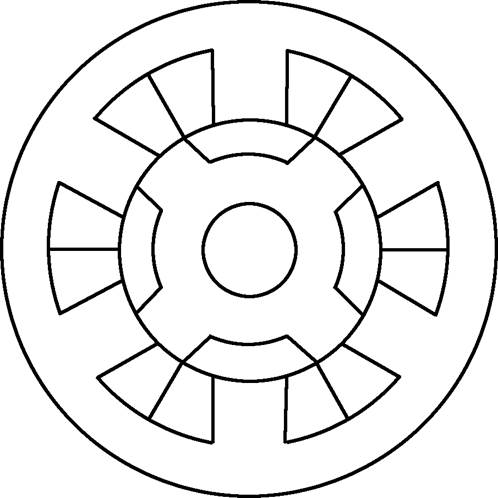
图1 三相6/4开关磁阻电机
Fig.1 Three-phase 6/4 SRM
摘要 针对开关磁阻电机径向电磁力严重的非线性问题,首先采用基于磁动势乘以磁导的解析法并结合铁心材料特性曲线,来预测开关磁阻电机的饱和磁场,然后运用麦克斯韦应力方程求解得到非线性的径向电磁力。该解析法可用于求解任意极对数的开关磁阻电机在任意转子位置下的径向电磁力。结果表明,解析结果与有限元结果整体吻合较好,进一步验证了该方法的有效性,从而为开关磁阻电机的振动噪声预测与优化研究奠定基础。
关键词:开关磁阻电机 磁饱和 径向电磁力 解析法
近年来,开关磁阻电机(Switched Reluctance Motor, SRM)在航空航天、高速离心压缩机、电动车、矿山等领域得到广泛应用,主要是由于其具有鲁棒性强、结构简单、耐高温、成本低等优点[1-3]。但开关磁阻电机相对永磁同步电机和感应电机有较大的振动噪声,阻碍了其进一步推广,并且径向电磁力是其振动噪声的主要来源[4-6]。因此,有必要建立一个能精准体现电机参数的气隙径向电磁力解析模型,为快速预测及优化开关磁阻电机的振动噪声奠定基础。
目前,开关磁阻电机径向电磁力的解析建模主要运用基于虚功原理的解析法。文献[7-10]运用虚功原理解析得到开关磁阻电机的电磁力,分析了不同参数对电磁力的影响,为电机的电磁振动噪声优化提供理论基础。文献[11]也基于虚功原理推导了开关磁阻电机由转子偏心引起的不平衡电磁力解析模型,并通过有限元结果进行验证;但上述文献所提的解析法既没有考虑饱和电磁力的非线性特性,也不能用于分析电磁力的时空分布特性。文献[12]则基于磁路分析法提出了一种简化的开关磁阻电机径向电磁力解析模型,并考虑了饱和效应的影响。文献[13]基于麦克斯韦张量法与磁路分析法,提出了一种计算无轴承开关磁阻电机径向电磁力的数学模型,能准确地描述电机在磁饱和状态下产生的径向电磁力特性,并通过有限元法进行验证,为电机的电磁振动噪声预测与控制提供了更为可靠的理论依据。文献[14-15]进行了考虑饱和及互感的开关磁阻电机解析建模,探讨了饱和对电机性能的影响,但分析需要借助于有限元仿真得到的数据表。文献[16]建立了平面二维开关磁阻电机非线性电磁力解析模型,但其体现电机饱和的参数仍是通过有限元法获得的。上述文献虽然考虑了开关磁阻电机电磁力的饱和效应,但需要借助有限元仿真数据,并且未体现电磁力的时空分布特性。
综上所述,目前开关磁阻电机的双凸极结构导致的饱和问题一直是非线性径向电磁力解析建模的难点。本文主要是针对开关磁阻电机的磁饱和问题,建立非线性径向电磁力的纯解析模型。
本文选用传统的三相6/4开关磁阻电机,结构外廓如图1所示,电机的主要参数见表1。

图1 三相6/4开关磁阻电机
Fig.1 Three-phase 6/4 SRM
本文主要采用磁动势乘以磁导法建立气隙径向磁通密度解析模型,其具体建模思路如下。
开关磁阻电机的第q相绕组的磁动势的空间分布如图2所示,具体表达式如式(1)所示。其中,a =Nrq,a 与q 均为空间角度,但a 为电角度,q 为机械角度。
表1 三相6/4开关磁阻电机参数
Tab.1 Parameters of three-phase 6/4 SRM
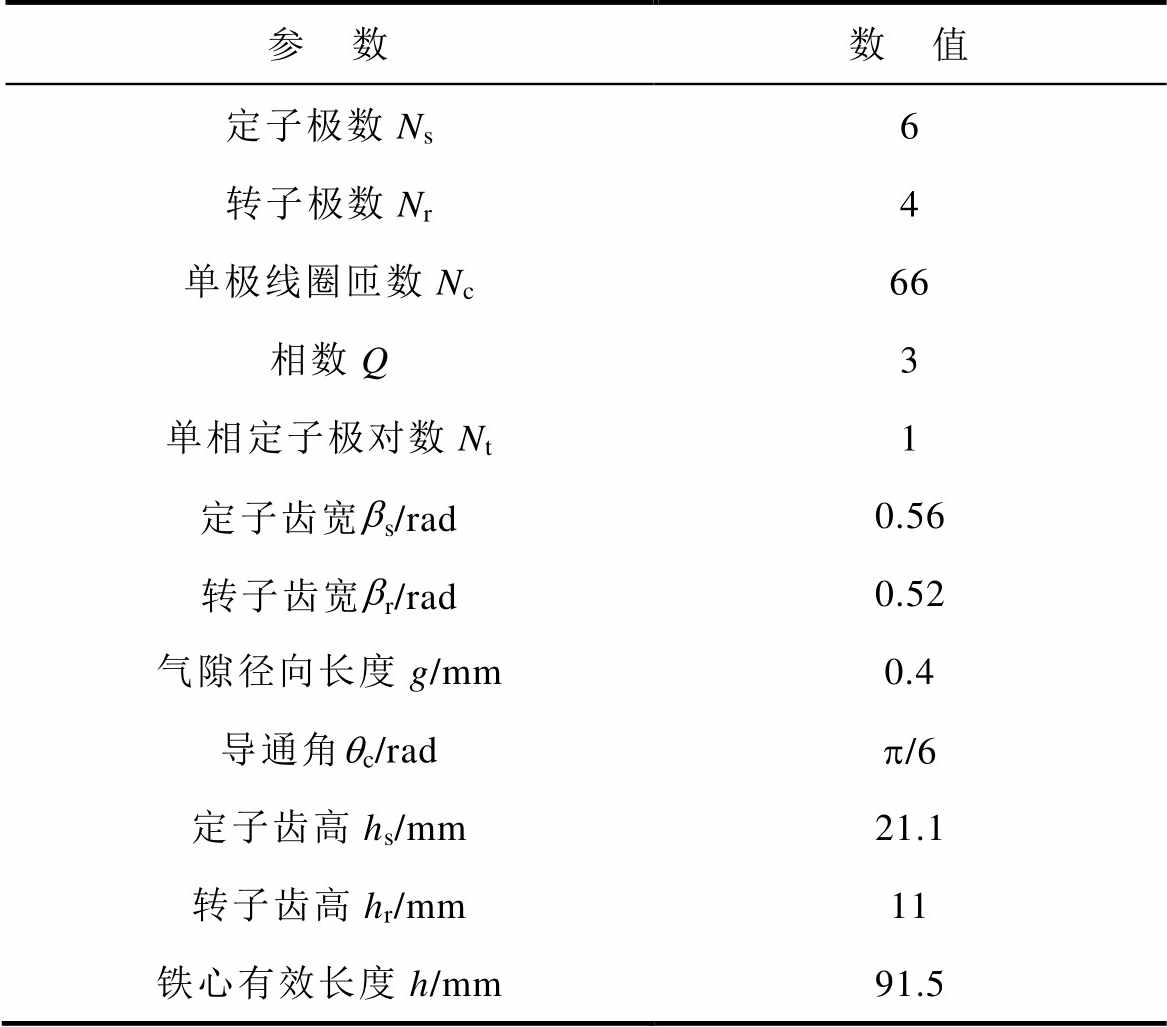
参 数数 值 定子极数Ns6 转子极数Nr4 单极线圈匝数Nc66 相数Q3 单相定子极对数Nt1 定子齿宽bs/rad0.56 转子齿宽br/rad0.52 气隙径向长度g/mm0.4 导通角qc/radp/6 定子齿高hs/mm21.1 转子齿高hr/mm11 铁心有效长度h/mm91.5

图2 磁动势的空间分布(电角度)
Fig.2 Spatial distribution of magnetomotive force
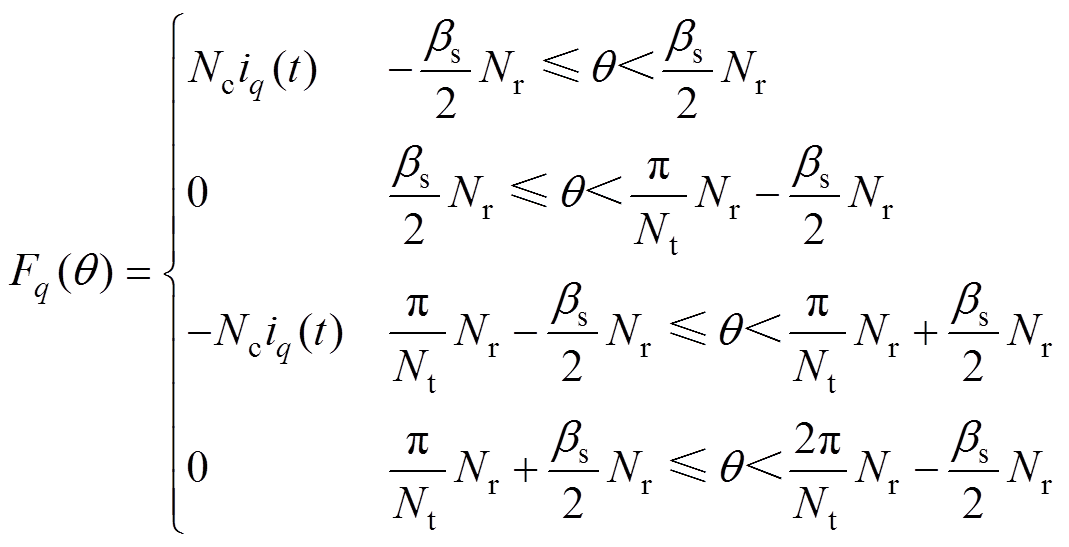 (1)
(1)式中,iq为第q相的电流,且q满足1≤q≤Q;Nt= Ns/(2Q)。
那么,第q相绕组的磁动势傅里叶级数展开为
 (2)
(2)式中,Fv的取值为
![]() (3)
(3)
第q相电流的时间分布如图3所示,具体表达式为
 (4)
(4)
图3 第q相电流的时间分布(电角度)
Fig.3 Temporal distribution of qth phase current
式中,qc为导通角,w 为角速度。
第q相电流随时间变化的傅里叶级数展开为
 (5)
(5)式中,Ii的取值为
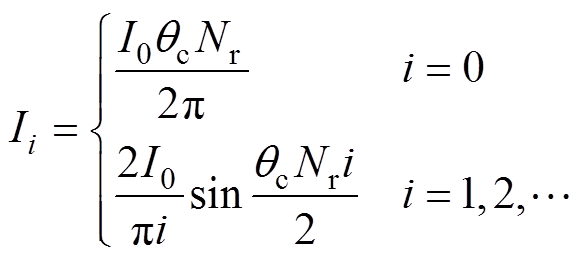 (6)
(6)
将式(5)代入式(3),式(3)再代入式(2),并经化简后可得第q相绕组的磁动势傅里叶级数展开式为
 (7)
(7)式中,Kvi为与v、i有关的磁动势系数,v=1, 3, 5,…,即
 (8)
(8)
令u=vNt,式(7)可以写成
 (9)
(9)式中,Kui为与u、i有关的磁动势系数。
根据开关磁阻电机的工作原理,对于不同相绕组的磁动势可以表示为
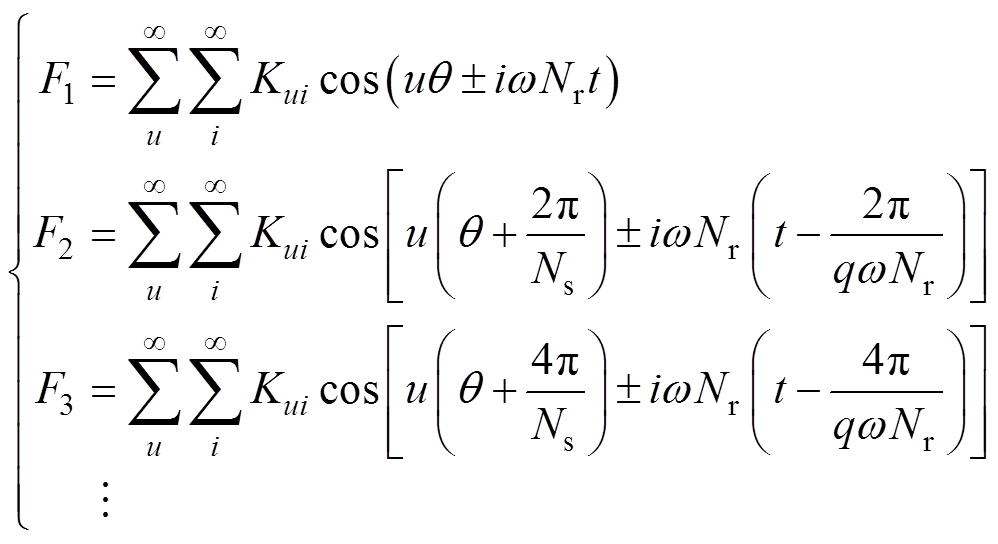 (10)
(10)根据文献[17],可知不考虑开槽的第q相绕组的径向磁通密度为
 (11)
(11)
式中,L0为磁导,L0=m0/g。
可得不考虑开槽的第q相绕组的气隙径向磁通密度为
 (12)
(12)式中,m0为空气磁导率。
由于开关磁阻电机是双凸极结构,即定转子均开槽,如图1所示,所以解析气隙域磁通密度时应考虑定子与转子的开槽影响。假设定子未开槽部分的系数为1,开槽后的影响系数为es。es为定子槽中心处的磁通密度与定子齿中心处的磁通密度的比值,它的值可以通过对槽周围的磁场分布云图分析得到[18]。那么一个定子极距内的开槽影响系数的空间分布如图4所示。定子开槽影响系数的傅里叶级数展开式为
 (13)
(13)式中,ls0与lsm的值分别为
 (14)
(14)
 (15)
(15)
图4 定子开槽影响系数的空间分布(电角度)
Fig.4 Spatial distribution of influence coefficient of stator slotting
对于转子开槽的影响分析与定子一样,同样假设转子未开槽部分的系数为1,转子开槽后的影响系数为er,er为转子槽中心处的磁通密度与转子齿中心处的磁通密度的比值。那么,一个转子极距内的开槽影响系数空间分布如图5所示。
转子开槽影响系数的傅里叶级数展开式为
 (16)
(16)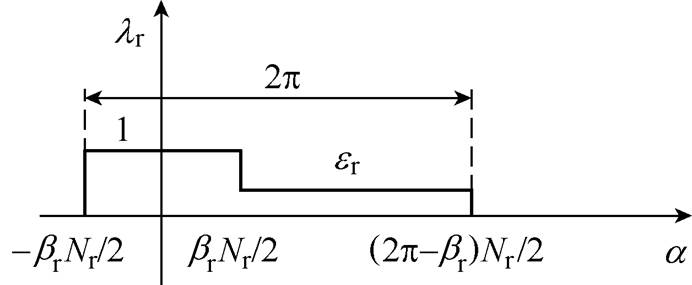
图5 转子开槽影响系数的空间分布(电角度)
Fig.5 Spatial distribution of influence coefficient of rotor slotting
式中,lr0与lrn的值分别为
 (17)
(17) (18)
(18)
进一步可得定转子开槽影响系数的乘积为
 (19)
(19)通过上述分析,分别得到了不考虑开槽的第q相绕组的径向磁通密度、定子开槽影响系数及转子开槽影响系数。根据考虑开槽的径向磁通密度计算式
 (20)
(20)可以得到考虑开槽后的第q相绕组的径向磁通密度,经化简后得
 (21)
(21)
由于本文所选电机为传统三相6/4开关磁阻电机,即绕组共有三相且 满足1≤q≤Q(Q =3),并且相邻相的耦合程度远不及互耦式开关磁阻电机严 重[19-20],可忽略相邻相耦合给磁通密度带来的影响。那么,气隙中的线性径向磁通密度Br,lin为三相绕组气隙径向磁通密度的叠加,即
满足1≤q≤Q(Q =3),并且相邻相的耦合程度远不及互耦式开关磁阻电机严 重[19-20],可忽略相邻相耦合给磁通密度带来的影响。那么,气隙中的线性径向磁通密度Br,lin为三相绕组气隙径向磁通密度的叠加,即
 (22)
(22)通过式(22)解析得到的线性径向磁通密度,还需进一步考虑饱和问题。本文采用分布式的等效磁阻和动态磁导率来解决气隙径向磁通密度的饱和问题。假设定、转子的相对位置如图6所示,将空间圆周的气隙划分为n份。每一份的饱和磁场可通过图6的等效磁路来分析,且每一份的等效磁阻Rm等于气隙磁阻R0与定转子铁心磁阻R1(定义为串联磁阻R1)的叠加。由于开关磁阻电机局部磁饱和主要集中于定子齿与转子齿的前半部分,所以串联磁阻R1的长度l近似为定子齿与转子齿长度总和的一半,即(hs+hr)/2。另外,d0是每一份等效磁阻的宽度,hs/2是定子铁心磁阻的长度,hr/2是转子铁心磁阻的长度。
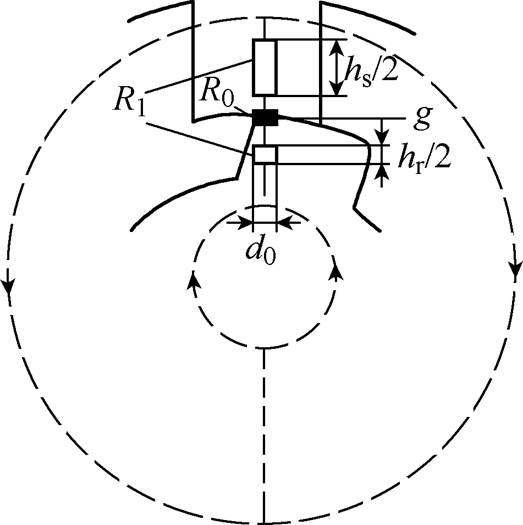
图6 等效磁路
Fig.6 Equivalent magnetic circuit
图6中的气隙磁阻R0和串联磁阻R1分别为
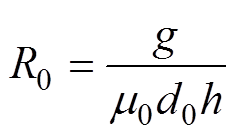 (23)
(23) (24)
(24)
式中,md为动态磁导率。
那么,等效磁阻Rm为
 (25)
(25)另外,磁通与磁通密度的计算式分别为
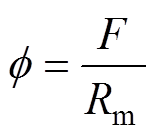 (26)
(26)
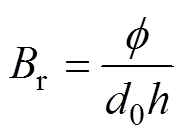 (27)
(27)将式(21)、式(23)~式(26)代入式(27),可得考虑饱和的气隙径向磁通密度Br,sat,进一步可获取考虑饱和的气隙径向磁通密度Br,sat与线性径向磁通密度Br,lin之间的关系式为
 (28)
(28)
在式(28)中,仅需要确定动态磁导率md的值,就能求得考虑饱和的气隙径向磁通密度Br,sat。并且从定、转子铁心材料的B-H特性曲线,可以获取不同磁通密度下的动态磁导率md,构成md-B曲线,如图7所示。
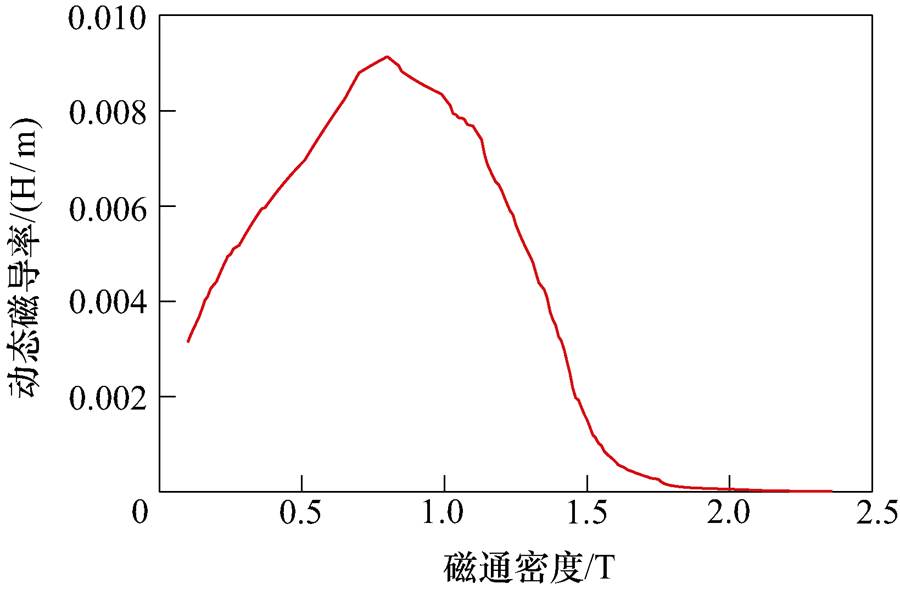
图7 动态磁导率md随磁通密度B变化曲线
Fig.7 Dynamic permeability with flux density
根据式(11)、式(20)、式(22)与式(28)可得
 (29)
(29)为求解此方程,运用基本的数学平衡方程求解法,并结合图7的md-B曲线,搭建了图8的饱和磁场算法。式(29)中的F1+F2+F3为输入磁动势的和,其值由绕组匝数和实际电流大小决定;而输出磁动势的和f1+f2+f3则通过式(30)求解得到。另外,借助Matlab/Simulink即可快速求解,进而可求得考虑饱和的气隙径向磁通密度。

图8 饱和磁场算法
Fig.8 Saturated magnetic field algorithm
 (30)
(30)图9为运用此方法解析得到的三相6/4极开关磁阻电机在转子两个不同位置下的气隙径向磁通密度。其中,图9a的气隙径向磁通密度是转子在图10a位置下获得的;而图9b的气隙径向磁通密度是转子在图10b位置下获得的。从图9可以看出,运用此方法解析得到的径向磁通密度与有限元结果整体吻合较好。线性区域的解析结果稍有偏差,主要是由于此解析法仅能考虑径向磁通密度,而不能考虑到切向磁通密度的贡献。综上所述,此方法可用于预测开关磁阻电机的饱和磁场。
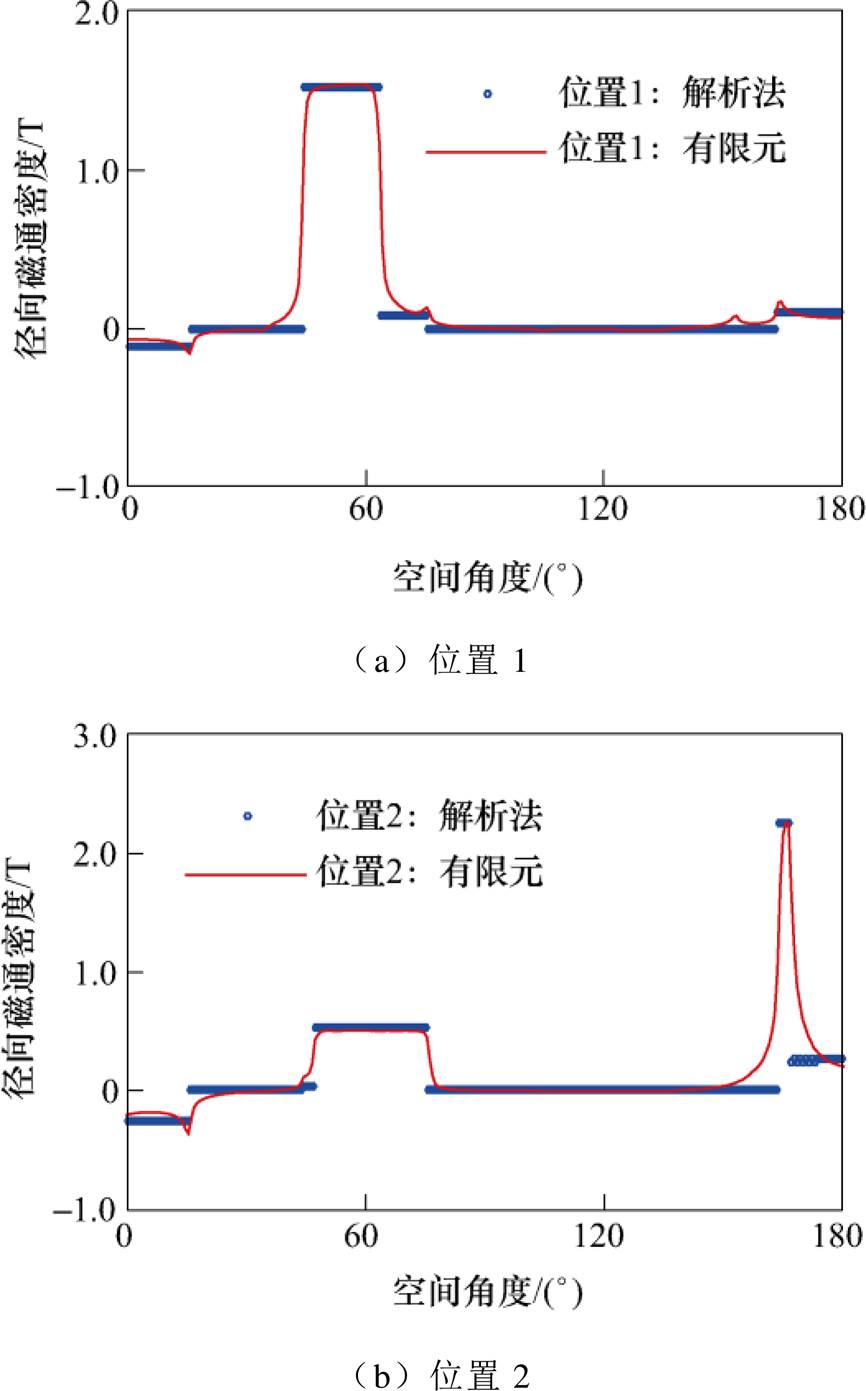
图9 转子在位置1与位置2下的径向磁通密度
Fig.9 Radial flux density when rotor is at position 1 and 2
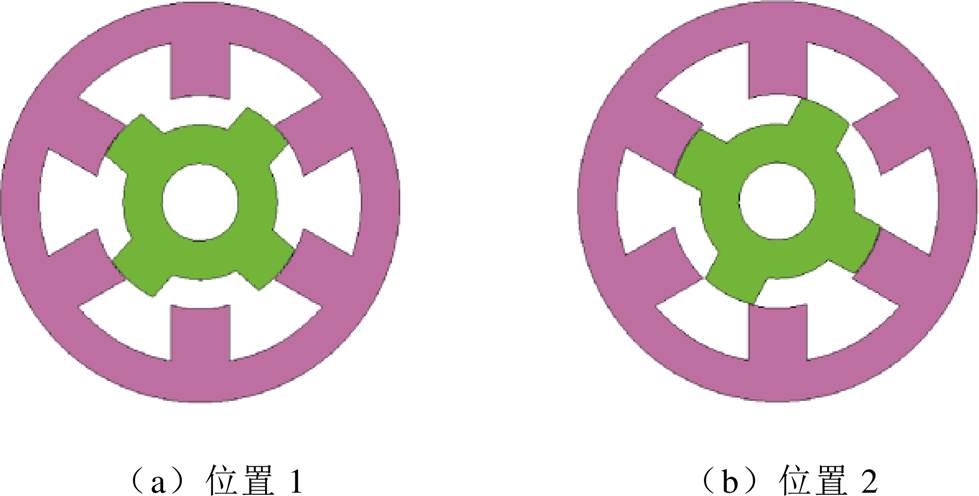
图10 转子的两个不同位置
Fig.10 Two different positions of rotor
再结合麦克斯韦应力方程[21-23],可进一步解析得到径向电磁力,并与有限元结果进行对比。由于切向磁通密度远小于径向磁通密度,故麦克斯韦应力方程可简化为
 (31)
(31)图10a转子位置下的径向电磁力解析结果如图11a所示;图10b转子位置下的径向电磁力解析结果如图11b所示。另外,转子在其他位置下的径向电磁力曲线族如图12所示,对应的转子位置如图13所示。从图11与图12的径向电磁力解析结果可知,在径向电磁力峰值两侧仍存在偏差,其主要原因在于本文所提的解析法只能求解径向磁通密度,而不能考虑切向磁通密度。但径向电磁力的解析结果与有限元结果的整体吻合程度较好,进一步验证了本文所提解析法的准确性。
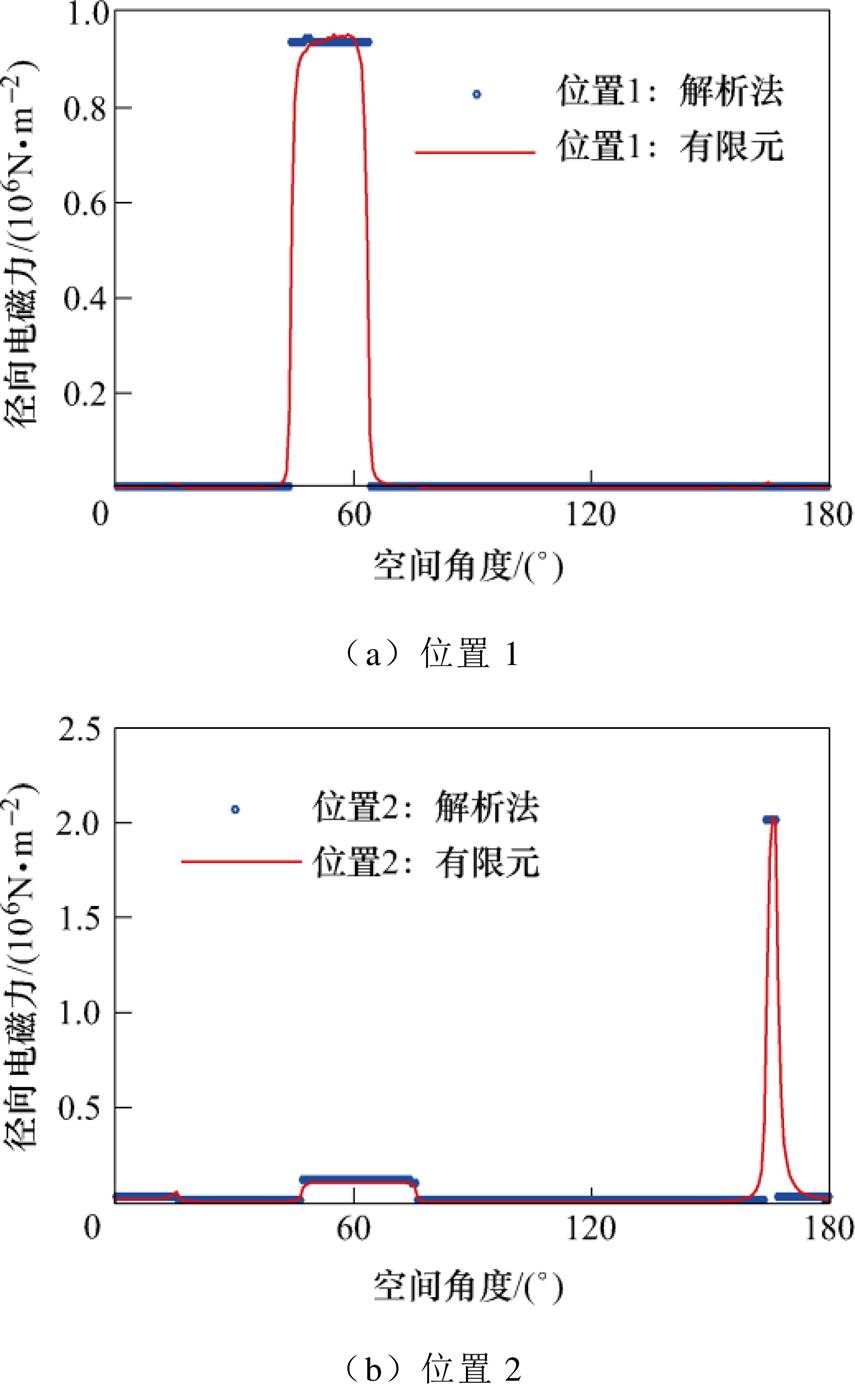
图11 转子在位置1与位置2下的径向电磁力
Fig.11 Radial electromagnetic force when rotor is at position 1 and 2
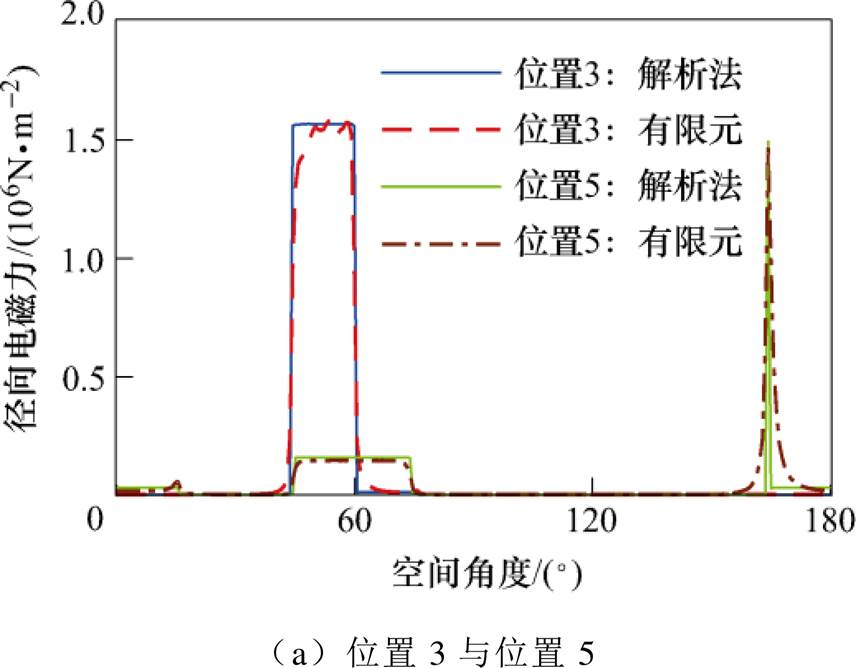

图12 转子在其他位置下的径向电磁力曲线族
Fig.12 A family of radial electromagnetic force curves when rotor is at other different positions
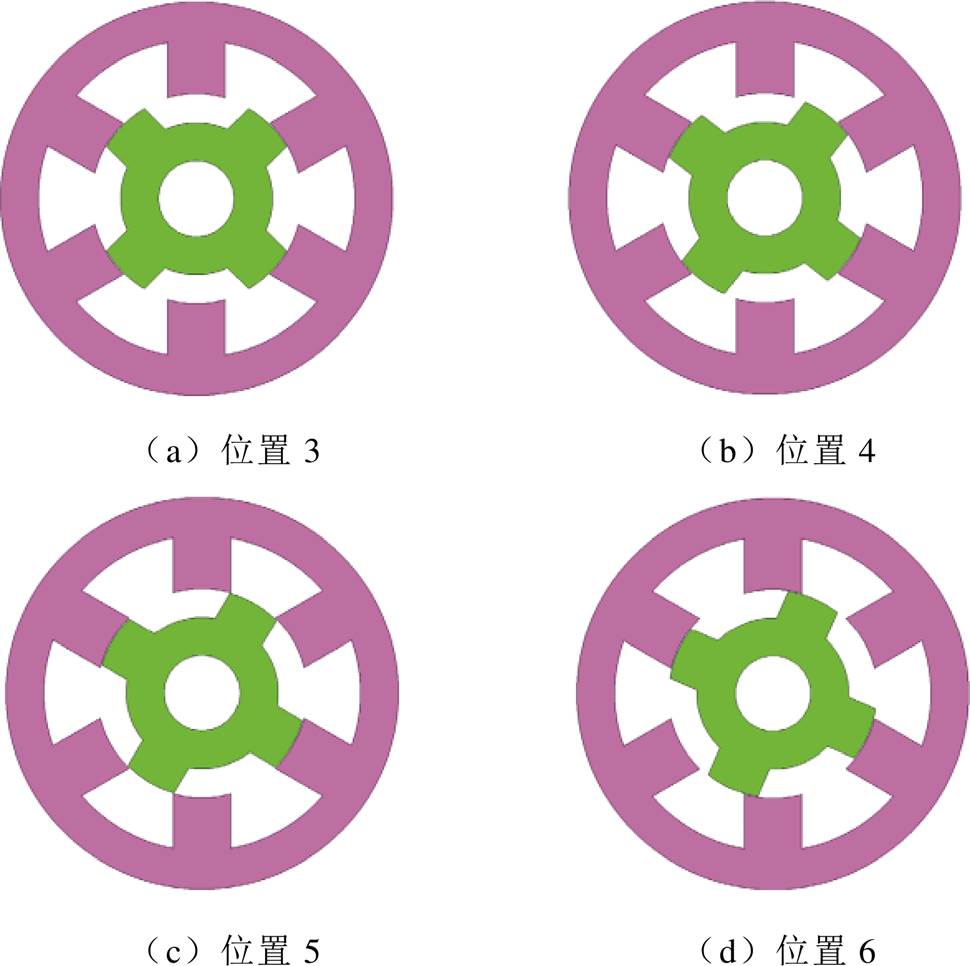
图13 转子的其他位置
Fig.13 Other different positions of rotor
本节主要总结了电流、绕组匝数、定子极弧与转子极弧对气隙径向磁通密度的影响规律,如图14所示。从图14a与图14b可知,电流与绕组匝数对径向磁通密度的影响规律一致,径向磁通密度的峰值随电流(或绕组匝数)的增大而增大。其次,从图14c与图14d可知,定子极弧与转子极弧不会影响径向磁通密度的幅值大小,但定子极弧(或转子极弧)增大后,径向磁通密度在空间圆周上的占比会更大。另外,根据式(31)可知,电流、绕组匝数、定子极弧与转子极弧对径向电磁力的影响规律与磁通密度一样,在此不再赘述。

图14 电流、绕组匝数、定子极弧与转子极弧对气隙径向磁通密度的影响
Fig.14 Influence of current, winding, stator arc and rotor arc on radial flux density
本文所提的解析法对任意极对数的开关磁阻电机在任意转子位置下均适用,可以很好地预测开关磁阻电机由饱和磁场引起的非线性径向电磁力。径向电磁力解析结果与有限元结果对比进一步验证了该方法的有效性,运用该方法解析得到的径向电磁力可用于开关磁阻电机的振动噪声预测与优化研究。另外,径向磁通密度与电磁力峰值均随电流(或绕组匝数)的增大而增大;而定子极弧与转子极弧的变化不会改变径向磁通密度与电磁力峰值的大小,仅会影响其在空间圆周上的分布范围。
参考文献
[1] 王峰, 吴志强, 李亚杰, 等. 开关磁阻电机转子径向电磁合力的解析建模[J]. 电工技术学报, 2019, 34(5): 934-945.
Wang Feng, Wu Zhiqiang, Li Yajie, et al. Analytical modeling of rotor radial electromagnetic force in switched reluctance motor[J]. Transactions of China Electrotechnical Society, 2019, 34(5): 934-945.
[2] 周凯, 石增. 开关磁阻电机转矩脉动抑制技术[J]. 电机与控制学报, 2019, 23(12): 85-92.
Zhou Kai, Shi Zeng. Torque ripple reduction technique for switched reluctance motor[J]. Electric Machines and Control, 2019, 23(12): 85-92.
[3] 蔡辉, 王辉, 李孟秋, 等. 考虑饱和电感特性的开关磁阻电机的无位置传感器控制方法[J]. 电工技术学报, 2018, 33(12): 2723-2734.
Cai Hui, Wang Hui, Li Mengqiu, et al. Position sensorless control of switched reluctance motors considering the magnetic saturation[J]. Transactions of China Electrotechnical Society, 2018, 33(12): 2723-2734.
[4] Guo Xiaoqiang, Zhong Rui, Zhang Mingshu, et al. Improved model of radial vibration in switched reluctance motor including magnetic saturation[J]. CES Transactions on Electrical Machines and Systems, 2018, 2(4): 363-370.
[5] Panda Debiprasad, Ramanarayanan V. Reduced acoustic noise variable DC-bus-voltage-based sensor- less switched reluctance motor drive for HVAC applications[J]. IEEE Transactions on Industrial Electronics, 2007, 54(4): 2065-2078.
[6] Chen Li, Hofmann Wilfried. Speed regulation technique of one bearingless 8/6 switched reluctance motor with simpler single winding structure[J]. IEEE Transactions on Industrial Electronics, 2012, 59(6): 2592-2600.
[7] Jens O Fiedler, Rik W De Doncker. Simplified calculation of radial force spectrum in SRM for acoustic noise prediction in preliminary machine design[C]//3rd IET International Conference on Power Electronics, Machines and Drives, Dublin, 2006: 652-656.
[8] 孙剑波. 开关磁阻电机的减振降噪和低转矩脉动研究[D]. 武汉: 华中科技大学, 2005.
[9] Takemoto M, Suzuki H, Chiba A, et al. Improved analysis of a bearingless switched reluctance motor[J]. IEEE Transactions on Industry Appli- cations, 2001, 37(1): 26-34.
[10] Li Jie, Sun Hexu, Fan Shurui, et al. Switched reluctance motor's magnetic force analysis and the drive system simulation verification[C]//2nd Inter- national Conference on Industrial and Information Systems, Dalian, 2010: 210-214.
[11] Hinterdorfer Thomas, Schulz Alexander, Sima Harald. Force prediction and radial force compensation of a switched reluctance motor[C]//39th Annual Con- ference of the IEEE Industrial Electronics Society, Vienna, 2013: 2875-2880.
[12] Ji Jinghua, Sun Yukun, Zhao Wenxiang, et al. Calculation and remedial strategy of radial force of switched reluctance motors with eccentricity[C]// International Conference on Electrical Machines and Systems, Wuhan, 2008: 3932-3935.
[13] 杨艳, 邓智泉, 曹鑫, 等. 无轴承开关磁阻电机径向电磁力模型[J]. 电机与控制学报, 2009, 13(3): 377-382, 388.
Yang Yan, Deng Zhiquan, Cao Xin, et al. Magnetic radial force model of bearingless switched reluctance motors[J]. Electric Machines and Control, 2009, 13(3): 377-382, 388.
[14] Mhatli Kais, Ben Salah B. Improved modeling of switched reluctance motor including mutual and saturation effects[C]//15th IEEE Mediterranean Electrotechnical Conference, Valletta, 2010: 1470- 1475.
[15] Ding Wen, Lou Jianyong, Liu Ling. Improved decoupled model of mutually coupled dual-channel SRM with consideration of magnetic saturation in dual-channel operation[J]. IET Electric Power Appli- cations, 2013, 7(6): 427-440.
[16] Cao Guangzhong, Li Linglong, Huang Sudan, et al. Nonlinear modeling of electromagnetic forces for the planar-switched reluctance motor[J]. IEEE Transa- ctions on Magnetics, 2015, 51(11): 1-5.
[17] Gaussens Benjamin, Hoang Emmanuel, De La Barriere Olivier, et al. Analytical armature reaction field prediction in field-excited flux-switching machines using an exact relative permeance function[J]. IEEE Transactions on Magnetics, 2013, 49(1): 628-641.
[18] Bai Hua, Pekarek Steven D, Tichenor Jerry, et al. Incorporating the effects of magnetic saturation in a coupled-circuit model of a claw-pole alternator[J]. IEEE Transactions on Energy Conversion, 2007, 22(2): 290-298.
[19] Li Guangjin, Ojeda Javier, Hlioui Sami, et al. Modification in rotor pole geometry of mutually coupled switched reluctance machine for torque ripple mitigating[J]. IEEE Transactions on Magnetics, 2012, 48(6): 2025-2034.
[20] Liang Xiaobin, Li Guangjin, Ojeda Javier, et al. Comparative study of classical and mutually coupled switched reluctance motors using multiphysics finite-element modeling[J]. IEEE Transactions on Industrial Electronics, 2014, 61(9): 5066-5074.
[21] 钟鸿敏, 左曙光, 吴旭东, 等. 电励磁爪极发电机气隙磁场与径向电磁力的解析计算模型[J]. 电工技术学报, 2017, 32(7): 49-58.
Zhong Hongmin, Zuo Shuguang, Wu Xudong, et al. Analytic model of air gap magnetic field and radial electromagnetic force for electric excitation claw pole alternator[J]. Transactions of China Electro- technical Society, 2017, 32(7): 49-58.
[22] 林福, 左曙光, 毛钰, 等. 考虑电流谐波的永磁同步电机电磁振动和噪声半解析模型[J]. 电工技术学报, 2017, 32(9): 24-31.
Lin Fu, Zuo Shuguang, Mao Yu, et al. Semi- analytical model of vibration and noise for permanent magnet synchronous motor considering current harmonics[J]. Transactions of China Electrotechnical Society, 2017, 32(9): 24-31.
[23] 邓文哲, 左曙光, 林福, 等. 偏心条件下轴向磁通轮毂电机不平衡弯矩建模与分析[J]. 电工技术学报, 2017, 32(13): 153-161.
Deng Wenzhe, Zuo Shuguang, Lin Fu, et al. Modeling and analysis of unbalanced moment for an axial-flux in-wheel motor with eccentricity[J]. Transactions of China Electrotechnical Society, 2017, 32(13): 153-161.
Analytical Modeling of Nonlinear Radial Electromagnetic Force in Switched Reluctance Motors
Abstract This paper aims at accurately predicting the nonlinear radial electromagnetic force in switched reluctance motors (SRMs). First, the saturated magnetic field of a SRM was predicted by the analytical method based on the magnetomotive force multiplying the permeance and the characteristic curve of the core material. Then, the nonlinear radial electromagnetic force was obtained by solving the Maxwell stress equation. The proposed analytical method can predict the radial electromagnetic force in SRMs with an arbitrary number of stator poles and rotor poles at an arbitrary rotor position. The results show that the radial electromagnetic force obtained by the analytical method is in good agreement with that of the finite element method, which further verifies proposed method. It lays the foundation for the vibroacoustic prediction and optimization of SRMs.
keywords:Switched reluctance motor, saturated magnetic, radial electromagnetic force, analytical method
中图分类号:TM352
DOI: 10.19595/j.cnki.1000-6753.tces.181902
国家自然科学基金资助项目(51875410)。
收稿日期 2018-12-17
改稿日期 2019-06-04
胡胜龙 男,1993年生,博士研究生,研究方向为电动车用开关磁阻电机电磁振动噪声研究及控制。E-mail: slhu825@163.com
左曙光 男,1968年生,教授,博士生导师,研究方向为汽车系统动力学与控制、汽车振动与噪声控制。E-mail: sgzuo@tongji.edu.cn(通信作者)
(编辑 赵 鹏)